Complete Solutions to QUESTION BANK of chapter DESCRIBING MOTION of Class 9 book with complete answers and questions
| Class 9 | PHYSICS |
| Chapter | DESCRIBING MOTION |
| BHARATI BHAWAN | QUESTION BANK |
| Number Of Questions | 51 |
| Academic Year | 2023-24 |
Consider the situation shown In Figure 2.3. What is the position of a particle when it is at `P_1`and when it is at `P_2`?

View SolutionConsider the situation shown In Figure 2.3.Are the two positions the same?

View SolutionConsider the situation shown In Figure 2.3.Are the two distances of the particle from the particle from the origin the same ?

View SolutionThe position of a particle going along a straight line is x=50m at 10.30 a.m. and x= 55 m at 10.35 a.m.
View SolutionConvert 15 m/s into km/h
View SolutionA boy throws a ball up and catches it when the ball falls back. In which part of the motion is the ball decelerating ?
View SolutionFigure 2.12 shows distance-time graphs of two objects A and B. Which object is moving with a greater speed when both are moving ?

View SolutionTwo friends A and B started from the same location and went 30 km along a road in the same direction. Figure 2.13 shows their motions through graphs. Answer. The following question.When did a start ?
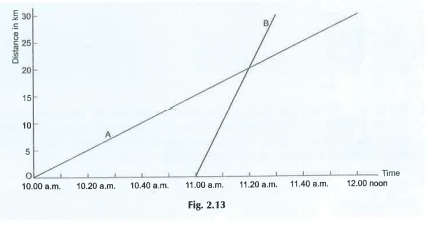
View SolutionTwo friends A and B started from the same location and went 30 km along a road in the same direction. Figure 2.13 shows their motions through graphs. Answer. The following question.When did B start ?

View SolutionTwo friends A and B started from the same location and went 30 km along a road in the same direction. Figure 2.13 shows their motions through graphs. Answer. The following question.Did any of them move with uniform speed ?
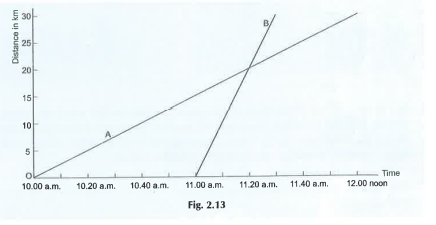
View SolutionThe velocity-time graph of a particle moving along a straight line is shown in Figure 2.W7.Is the motion uniform?
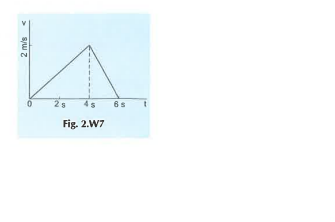
View SolutionThe velocity-time graph of a particle moving along a straight line is shown in Figure 2.W7.
Does the particle change its direction of motion ?
View SolutionA particle is travelling with a constant speed. This means
View SolutionA particle moves with a uniform velocity.
View SolutionIf a particle covers equal distances in equal time intervals, It is said to
View SolutionA quantity has a value of -6.0 m/s. It may be the
View SolutionThe area under a graph between two quantities is given in the unit m/s. The quantities are
View SolutionThe area under a speed -time graph is represented by the unit
View SolutionThe velocity-time graph of a particle is not a straight line. Its acceleration is
View SolutionIf a particle moves with a constant speed, the distance-time graph is
View SolutionThe distance-time graph of an object moving in a fixed direction is shown in figure 2.E1.
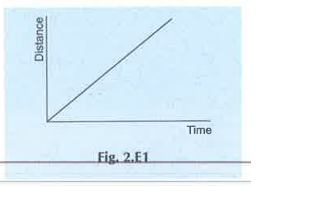
The object
View SolutionThe distance-time graph of an object shown in figure 2.E2.

The object
View SolutionThe speed-time graph of an object moving in a fixed direction is shown in figure 2.E3.
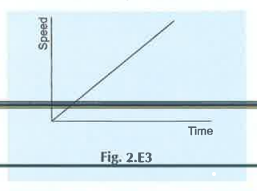
The object
View SolutionThe speed-time graph of an object moving in a fixed direction is shown in Figure 2.E4.
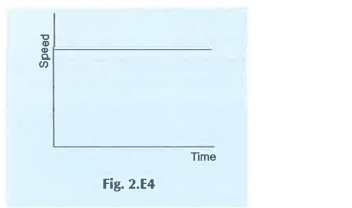
The object
View SolutionIn circular motion the
View SolutionMark the statement true (T) or false (F).If A moves with respect to B then B moves with respect to A.
View SolutionMark the statement true (T) or false (F).Scalar quantities can be added according to the rules of arithmetic.
View SolutionMark the statement true (T) or false (F). The magnitude of the displacement of a particle can be greater than the distance traversed.
View SolutionMark the statement true (T) or false (F). The magnitude of the displacement of a particle can be equal to the distance traversed.
View SolutionMark the statement true (T) or false (F).Vector quantities can be added according to the rules of arithmetic.
View SolutionMark the statement true (T) or false (F).The displacement of a particle in a 10-minute interval must be zero.
View SolutionMark the statement true (T) or false (F).A particle is known to be at rest at time t=0. Its acceleration at t=0 must be zero.
View SolutionMark the statement true (T) or false (F).For a particle moving with a constant velocity, the distance- time graph is a straight line.
View SolutionMark the statement true (T) or false (F). For a particle moving with a constant acceleration along a straight line, the velocity- time graph is a straight line.
View SolutionA car moves 100 m due east and then 25 m due west.What is its displacement ?
View SolutionA person walks along the sides of a square field. Each side is 100 m long. What is the maximum magnitude of displacement of the person in any time interval?
View SolutionIn the hare-tortoise race, the hare ran for 2 min at a speed of 7.5 km/h, slept for 56 min and aging ran for 2 min al a speed of 7.5 km/h . Find the average speed of the hare in the race.
View SolutionA boy leaves his house at 6.30 a.m. for his school. The school is 2 km away and classes start at 10.00 a.m. If he walks at a speed of 3 km/h for the second kilometre to reach just in time ?
View SolutionA bus moves at a uniform speed`v_1`for some time and then with a uniform speed `v_2`. The distance-time table is given below. Plot the corresponding distance-time graph and answer the following questions .

Find the values of `v_1` and `v_2`.
View SolutionA bus moves at a uniform speed`v_1`for some time and then with a uniform speed `v_2`. The distance-time table is given below. Plot the corresponding distance-time graph and answer the following questions .
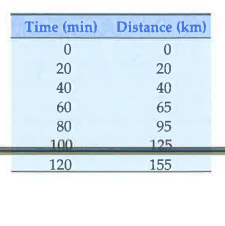
When did the bus change its speed?
View SolutionA bus moves at a uniform speed`v_1`for some time and then with a uniform speed `v_2`. The distance-time table is given below. Plot the corresponding distance-time graph and answer the following questions .
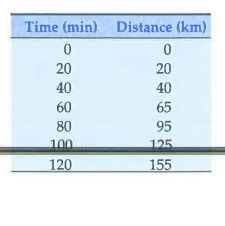
What is the average speed for the complete journey ?
View SolutionA bicycle increases its velocity from 10 km/h to 15 km/h in 6 seconds. Calculate its acceleration.
View SolutionA bullet hits a wall with a velocity of 20 m/s and penetrates it up to a distance of 5 cm. Find the deceleration of the bullet in the wall.
View SolutionA train starts from a station and moves with a constant acceleration for 2 minutes. If it covers a distance of 400m in this period, find the acceleration.
View SolutionA bicycle moves with a constant velocity of 5 km/h for 10 minutes and then decelerates at the rate `1 km/h^2`, till it stops. Find the total distance covered by the bicycle.
View SolutionFigure 2.E6 shows the speed-time graph of a bus.

In which period is the bus accelerating ?
View SolutionFigure 2.E6 shows the speed-time graph of a bus.

In which period is the bus decelerating ?
View SolutionFigure 2.E6 shows the speed-time graph of a bus.
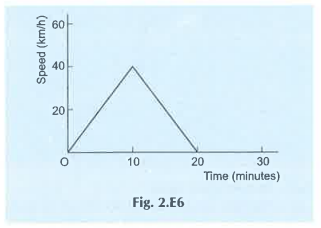
What is the distance covered during its deceleration ?
View SolutionFigure 2.E6 shows the speed-time graph of a bus.
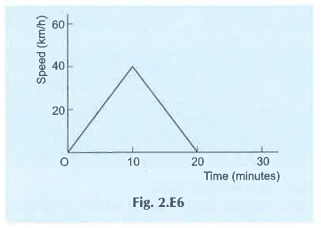
What is the distance covered during it deceleration ?
View SolutionThe velocity-time graph of a particle moving along a straight line is given in Figure 2E7.Does the particle ever come to rest ? If so , when ?

View SolutionThe velocity-time graph of a particle moving along a straight line is given in Figure 2E7.Does the particle turn around ?If so , when ?
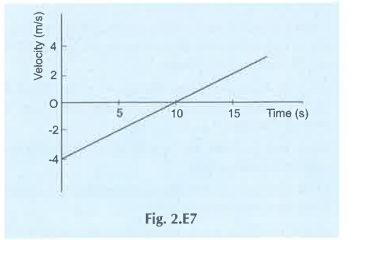
View Solution
QUESTION BANK questions and complete solutions for chapter DESCRIBING MOTION of HC VERMA of Class 9